Croda Lubricants
Leading the Way Naturally
By Jillian Beyer, Sales Development Specialist, Croda Lubricants | TLT CMF Plus November 2014
Introduction
Croda is known for its strong reputation in quality and innovation, helping customer’s solve problems by supplying them with high quality products from unique technology platforms.
With the move toward more environmentally acceptable materials, our corporate commitment to renewability and sustainability enables us to add value with our specialty products.
Croda’s products are targeted to add value in the following areas:
•
Improved fuel economy
•
Reduced emissions
•
Improved equipment durability
•
Increased production efficiency
•
Achieved sustainability objectives
Croda’s proven technology platform strengths include:
•
Ester technology (Priolube™)
•
Specialty effect additives (Perfad™, Crodacor™, Crodazoline™, and Crodasinic™)
•
Polymeric surfactants (Hypermer™)
•
Self-emulsifying surfactants combining lubrication and emulsification into one product
•
Polyalkylene glycols (Emkarox™)
•
Polymerized fatty acids (Prisorine™, Pripol™)
Through our application expertise, Croda utilizes its technology platforms to tackle the lubrication needs of today and the performance and legislative targets of the future.
Safer Food Production
In an effort to ensure safe food production, NSF International created three categories for lubricants. H1 lubricants are approved for incidental food contact, and H2 and H3 lubricants comprise all other areas. Food approved lubricants are typically only used where necessary, because nonfood grade lubricants have typically shown better performance. However, food approved lubricants can now offer the same performance as non-approved lubricants. As non-food approved lubricants cannot come into contact with food at all, by using food approved lubricants exclusively, it eliminates the possibility of contamination.
As part of this initiative, the FDA introduced the Food Safety Modernization Act (FSMA). This initiative focuses on ensuring that food manufacturers are preventing contamination outbreaks and quickly containing any that do occur. As a result of this act, high risk food plants are now inspected every 3-5 years. There are three key elements of the food safety plan: implement the preventative controls designed to minimize and prevent hazards, monitor the plan to ensure the controls are effective and to re-evaluate if not, and verify the plan is providing the desired effect of reducing the risk of contamination. All three elements ultimately contribute to ensure food safety.
Although this is a voluntary program, there are consequences for not complying. There have been a number of product recalls surrounding the cross-contamination of a non-food approved lubricant where a food approved lubricant was needed. For instance, 86,000lbs of sliced and packaged turkey was contaminated by a non-food grade lubricant, causing consumer complaints of off-color, odor and flavor. Just over 490,000lbs of smoked, boneless ham was recalled due to complaints of unpleasant taste and a burning sensation in the throat because it was exposed to a gear lubricant. And 55 tons of seasonings were recalled due to mineral-oil contamination – a recall that cost the manufacturer an estimated $1.9 million in damages!
In order to address these concerns and ultimately help food plant manufacturers avoid hefty fines, Croda has launched three new esters that are registered as HX-1 ingredients for incidental food contact by NSF (for use in H1 lubricants).
Priolube™ 2568 (ISO 68), Priolube 2510 (ISO 100) and Priolube 2520 (ISO 220) are all safe for food operations. In addition, these products provide the added benefit of reducing lubricant consumption compared to mineral oils, due to their high thermal stability up to 230°C. The high thermal stability provided by these polyol esters can contribute to less downtime to clean deposits from oven chains.
A thin film oxidation test was conducted in order to measure the weight loss and residue. The test was conducted on 97% base oil with a 3% antioxidant package. Samples were heated to 230°C for a total of 8 hours, at which point the percent weight loss was determined. Excess liquid was then drained from the dish to determine the amount of residue left behind. Low weight loss, meaning the lubricant stayed on the chain during operation and didn’t volatize off, and low residue, meaning the lubricant remained liquid during full operation and had a clean burn off, were the goals.
Figure 1 demonstrates the high performance of Croda’s three new esters. The blue bar shows the percent weight loss and the red bar is the percent residue. The products were compared against a trimellitate ester because it is commonly used for chain oil applications, and although it performed well, it does not offer food approval. Priolube 2568, 2510 and 2520 were also compared to a group II mineral oil, demonstrating that Croda’s esters provide significantly better performance.
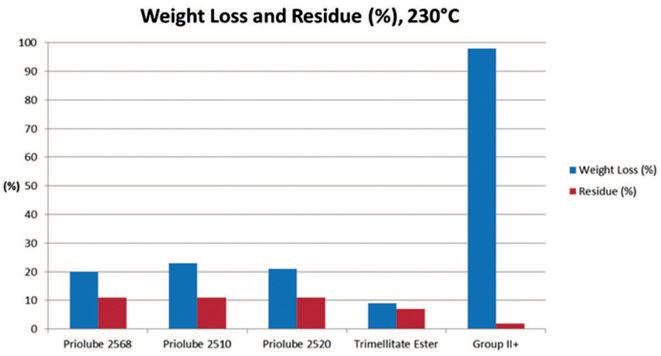 Figure 1.
Improving Fuel Economy Under New Environmental Regulations
Figure 1.
Improving Fuel Economy Under New Environmental Regulations
Environmental regulations are driving the move toward improved fuel economy, and therefore better performing friction modifiers to meet these needs. The first license date for the next passenger car engine oil category, GF-6, is scheduled for January 2017, calling for improvements in fuel economy and fuel retention. This new GF-6 specification is proposed to be 50% more difficult than GF-5. The GF-6 specification and tests are being developed to address the needs expressed by the automotive OEMs, including increased fuel economy, enhanced oil robustness to work better with newer engine design, and adequate wear protection for frequently started engines.
In order to address these needs, Croda continues to innovate in the area of polymeric friction modifiers. Within the past year, Croda has introduced
Perfad™ 3006, which complements the existing portfolio of
Perfad 3000 and
Perfad 3050 organic polymeric friction modifiers. This portfolio of friction modifiers are high viscosity polymers that deliver unprecedented friction reduction in engine oils. They form stable films under high loads and slow speeds, which result in low friction between moving parts, and in turn can lead to a reduction in wear. They do not contain sulfur, phosphorous, or sulfated ash and will not contribute to after-treatment equipment contamination.
Figure 2 shows friction results based on a Mini-Traction Machine (MTM) at 125°C. In this figure, a neat base oil’s friction curve is plotted to help demonstrate how friction modifiers affect the performance. GMO provides no benefit in the boundary lubrication regime. Croda’s Perfad 3006 dramatically reduces the friction coefficient in the boundary regime and mixed lubrication regimes. Perfad 3000 and Perfad 3050, which are higher molecular weight polymeric molecules, show similar friction results throughout the entire speed range.
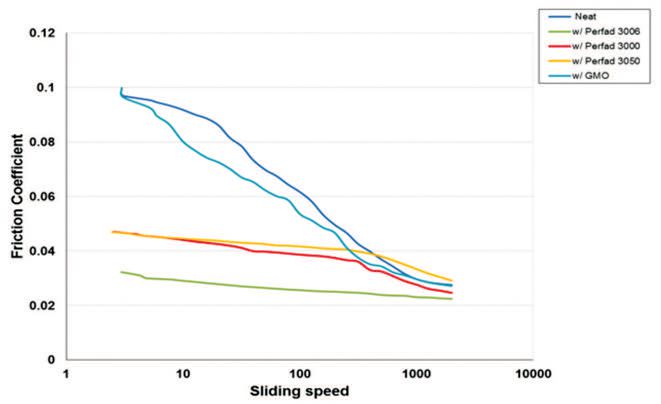 Figure 2.
Figure 2.
Croda has also studied how the Perfad polymeric products interact with ZDDP – an antiwear additive present in practically all automotive engine oils. Initial friction on a fresh metal surface was measured, as well as friction levels while allowing the film to fully develop, for a total of two hours. This data shows the benefit of using the Perfad series with ZDDP, compared to a molybdenum based friction modifier.
Figure 3 shows initial friction performance at 135°C and
Figure 4 shows friction performance after two hours of film formation. Perfad 3006 and Perfad 3050 offer the best frictional performance, having barely increased from their initial performance.
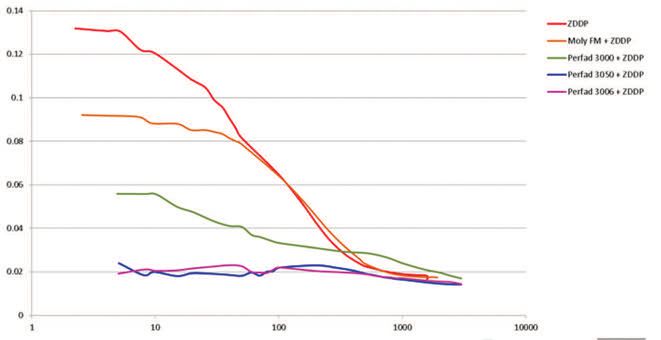 Figure 3.
Figure 3.
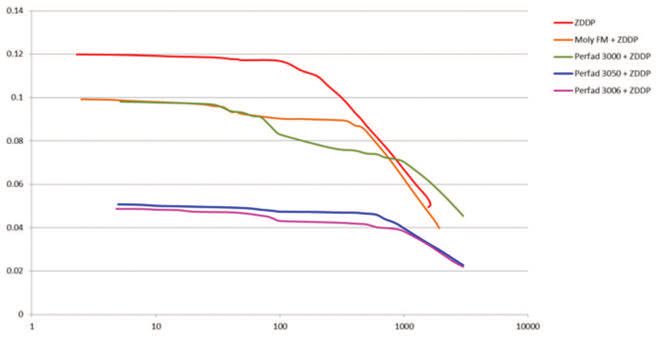 Figure 4.
Figure 4.
Friction modifier performance is formulation dependent, so what works well for one formulation may not work for every formulation. Croda suggests sampling the series of polymeric friction modifiers (Perfad 3000, 3006 and 3050) in order to find the best fit.
Biobased + High Performance
There is increased consumer awareness around sustainability and renewability, which is driving the growth for biobased lubricants.
The USDA has established a ‘bio-preferred products’ program, which recommends selecting biobased lubricants over petroleum based ones. This should increase the demand for biolubricants. In the past, there have been performance concerns with traditional biobased lubricants from vegetable oils because they showed low performing thermal stability and they had low temperature performance. However, Croda has had experience in this market for a long time and have synthetic ester biobased technology that has superior performance as well as high biobased content.
Croda offers a range of renewable esters. Four are certified as biobased under the USDA regulations and are distinguished by an asterick*. (
figure 5).
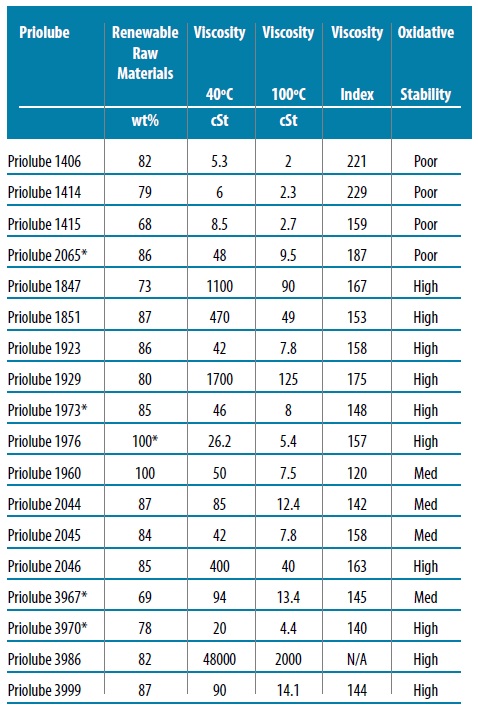 Figure 5.
New VGP Regulations = Better Performing Esters
Figure 5.
New VGP Regulations = Better Performing Esters
On December 19th, 2013, the EPA instituted the newest vessel general permit (VGP). This new permit requires the use of environmentally acceptable lubricants. Lubricants used must be biodegradable, minimally toxic, and must not bioaccumulate, or the lubricant must be in compliance with an approved international eco-labeling scheme.
In order to meet these requirements, Croda recommends using a selection of our synthetic ester base fluids (
figure 6). These products are part of the European eco-label and will soon be on the LUSC (Lubricant Substance Classification) list. These materials are particularly advantageous in the part of the vessel that require more frequent lubricant changes (engine oil, stern tube, hydraulic fluids) due to their higher oxidative stability.
Priolube Ester Base Fluids – Recommendations by ISO Grade
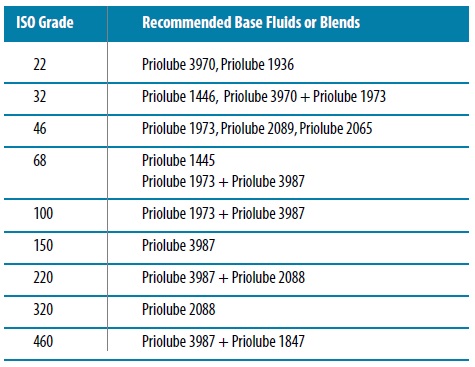 Figure 6.
Figure 6.
There are a number of new regulations and guidelines that are taking effect, such as VGP and GF-6. The future is bringing better and safer products to the market, and it is our responsibility to ensure we are complying.
Please join Croda in this effort.